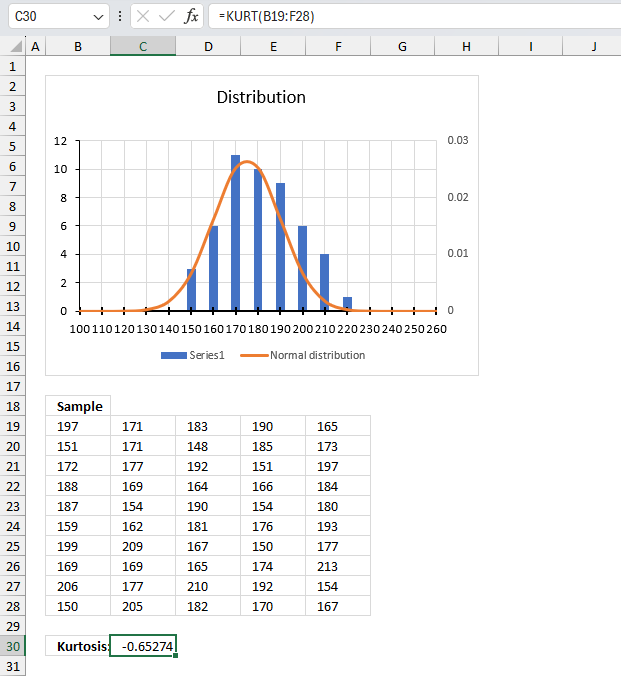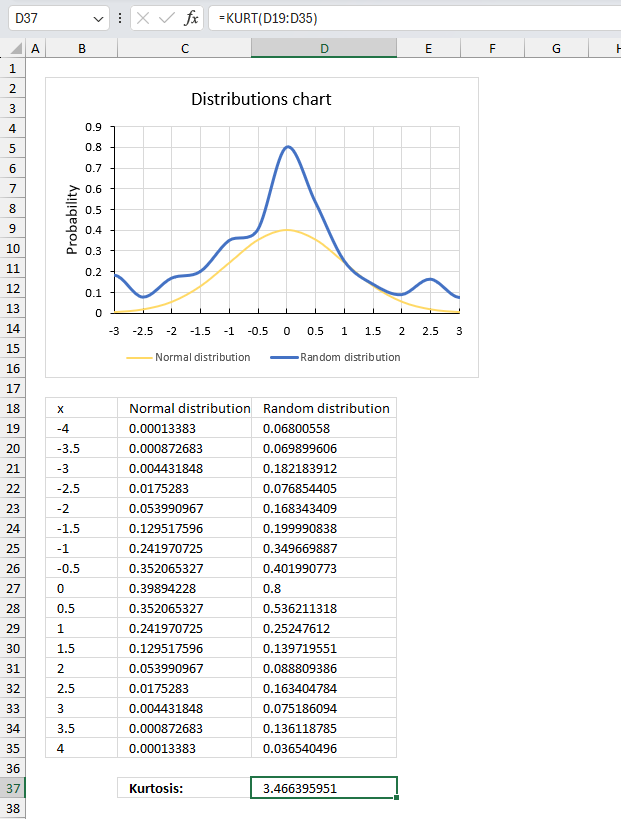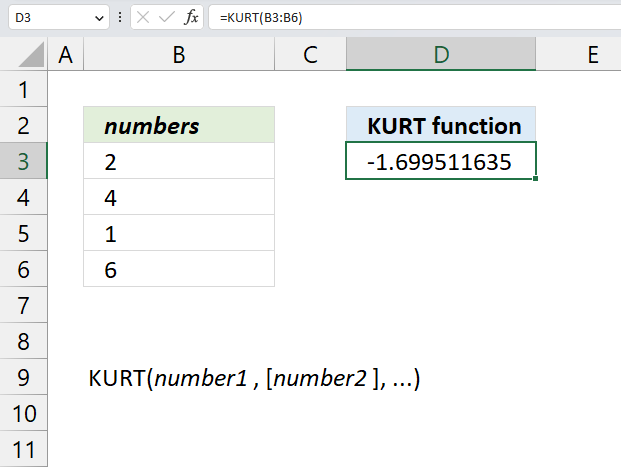How to use the KURT function

What is the KURT function?
The KURT function lets you calculate the sample excess kurtosis in Excel. The kurtosis shows the tailedness of a probability distribution, in other words, how often outliers (extreme values) occur. This number is not related to the peak of the distribution but to it's tails.
Table of Contents
1. Introduction
How to analyze the kurtosis value?
A high kurtosis number tend to indicate more outliers (heavy tails) in a distribution, whereas a small kurtosis value indicate less outliers (thin tails).
What is the difference between excess kurtosis and regular kurtosis?
The difference between excess kurtosis and regular kurtosis is in the way they are calculated and interpreted.
Regular kurtosis, also known as kurtosis or the fourth standardized moment, is a measure of the "tailedness" of a probability distribution. It describes how heavy the tails of a distribution are compared to a normal distribution. A higher kurtosis than 3 indicates that the distribution has heavier tails, while a lower kurtosis than 3 indicates lighter tails.
Excess kurtosis, also known as kurtosis excess or kurtosis risk, is calculated by subtracting 3 from the regular kurtosis value. The value 3 is subtracted because the normal distribution has a kurtosis of 3.
The formula for excess kurtosis is: Excess Kurtosis = Kurtosis - 3
What is the kurtosis and excess kurtosis of a normal distribution?
- The kurtosis of a normal distribution is 3 and is called a "mesokurtic".
A distribution with a higher kurtosis than three is called "leptokurtic", meaning that it has fatter tails than a normal distribution. A distribution with a lower kurtosis than three is called "platykurtic", meaning that it has thinner tails than a normal distribution.
The kurtosis ranges from 1 to infinity. - The excess kurtosis of a normal distribution is 0.
Excel calculates the "excess" kurtosis meaning a value larger than 0 (zero) is called "leptokurtic" and a kurtosis value smaller than 0 (zero) is called "platykurtic".
The excess kurtosis ranges from -2 to infinity.
What is the difference between kurtosis and skewness?
Skewness measures the symmetry of a distribution whereas kurtosis measures outliers or the tails of the distribution relative to a normal distribution.
A symmetric distribution has zero skewness, meaning that the data values are evenly distributed on both sides of the mean. An asymmetric distribution has either positive or negative skewness, meaning that the data values are more concentrated on one side of the mean than the other.
What are the formulas for the sample excess kurtosis and the population excess kurtosis?
Sample Excess Kurtosis = (n(n+1) / ((n-1)(n-2)(n-3))) * Σ((x_i - μ)4 / s4) - (3(n-1)2) / ((n-2)(n-3))
n is the sample size
x_i is the i-th observation
μ is the sample mean
s is the sample standard deviation
Population Excess Kurtosis = Σ(x - xmean)4/(Σ(x - xmean)2)2-3
μ_4 is the fourth central moment about the mean (Σ[(X - μ)4])
σ is the population standard deviation
μ is the population mean
2. Syntax
KURT(number1, number2, ...)
3. Arguments
| Argument | Description |
| number1 | Required. A single numerical value or a cell reference to multiple numerical values. |
| number2 | Optional. Up to 30 additional arguments. |
Text, logical values and empty cells are ignored.
The KURT function returns
- #DIV/0! error value if the number of values is less than 4.
4. Example 1

The image above shows two distributions, the first one is a normal distribution and the second one has random values. The values are in cell range D19:D35. The chart shows the normal distribution and another distribution containing more random values.
Formula in cell D37:
This formula returns 3.47 meaning the kurtosis is higher than 0 (zero). This tells us that the distribution in D19:D35 has "heavy" tails compared to the normal distribution, in other words, this distribution has more outliers which seems to be the case if you examine blue curve in the chart above.
5. Example 2

You are a scientist and has collected the following measurements of a peculiar phenomenon. Calculate the kurtosis? The data is presented in the table below.
| 197 | 171 | 183 | 190 | 165 |
| 151 | 171 | 148 | 185 | 173 |
| 172 | 177 | 192 | 151 | 197 |
| 188 | 169 | 164 | 166 | 184 |
| 187 | 154 | 190 | 154 | 180 |
| 159 | 162 | 181 | 176 | 193 |
| 199 | 209 | 167 | 150 | 177 |
| 169 | 169 | 165 | 174 | 213 |
| 206 | 177 | 210 | 192 | 154 |
| 150 | 205 | 182 | 170 | 167 |
The image above shows the data in cell range B19:F28, the chart above shows a normal distribution and a histogram represented by a column chart. The yellow line displays the normal distribution and the blue columns represents the frequency table of the data given in B19:F28.
Formula in cell C30:
The formula returns -0.65 which indicates that the distribution has thin tails, in other words, it has less number of outliers than a normal distribution.
6. How is the kurtosis calculated?

The math formula Excel uses to calculate the kurtosis is:

Xi is each value in the data set.
x ̅ is the average of all values.
n is the number of values.
s is the standard deviation. It is a measure of how spread out the values are.
Using the values 2, 4, 1, and 6 shown in the image above:
Average: 13/4 equals 3.25
n: 4
Standard deviation: 2.21735578260835
(How to use the STDEV.S function)
Step 1 - First part of the math formula

4*(4+1)/((4-1)*(4-2)*(4-3))
becomes
20/(3*2*1)
becomes
20/6 equals approx. 3.33333
Step 2 - Second part of the math formula

SUM(((B3:B6-AVERAGE(B3:B6))/H2)^4)
becomes
SUM((({2;4;1;6}-3.25)/2.21735578260835)^4)
becomes
SUM({-1.25;0.75;-2.25;2.75}/2.21735578260835)^4)
becomes
SUM(({-0.563734521002122;0.338240712601273;-1.01472213780382;1.24021594620467})^4)
becomes
SUM({0.10099468543522;0.0130889112324045;1.06020180982477;2.3658611031313})
and returns
3.54014650962367
Step 3 - Third part of the math formula

becomes
3*(4-1)^2/((4-2)*(4-3))
becomes
3*3^2/(2*1)
becomes
27/2 equals 13.5
Step 4 - Multiply and subtract

becomes
3.33333*3.54014650962367)-13.5
becomes
11.8004883654122-13.5
equals
-1.69951
This value matches the value calculated by the KURT function in cell D3, see the image below.

7. Function not working

KURT returns the #DIV/0! error value:
- if there are fewer than four data points.
- if the standard deviation of the sample equals 0 (zero)
7.1 Troubleshooting the error value

When you encounter an error value in a cell a warning symbol appears, displayed in the image above. Press with mouse on it to see a pop-up menu that lets you get more information about the error.
- The first line describes the error if you press with left mouse button on it.
- The second line opens a pane that explains the error in greater detail.
- The third line takes you to the "Evaluate Formula" tool, a dialog box appears allowing you to examine the formula in greater detail.
- This line lets you ignore the error value meaning the warning icon disappears, however, the error is still in the cell.
- The fifth line lets you edit the formula in the Formula bar.
- The sixth line opens the Excel settings so you can adjust the Error Checking Options.
Here are a few of the most common Excel errors you may encounter.
#NULL error - This error occurs most often if you by mistake use a space character in a formula where it shouldn't be. Excel interprets a space character as an intersection operator. If the ranges don't intersect an #NULL error is returned. The #NULL! error occurs when a formula attempts to calculate the intersection of two ranges that do not actually intersect. This can happen when the wrong range operator is used in the formula, or when the intersection operator (represented by a space character) is used between two ranges that do not overlap. To fix this error double check that the ranges referenced in the formula that use the intersection operator actually have cells in common.
#SPILL error - The #SPILL! error occurs only in version Excel 365 and is caused by a dynamic array being to large, meaning there are cells below and/or to the right that are not empty. This prevents the dynamic array formula expanding into new empty cells.
#DIV/0 error - This error happens if you try to divide a number by 0 (zero) or a value that equates to zero which is not possible mathematically.
#VALUE error - The #VALUE error occurs when a formula has a value that is of the wrong data type. Such as text where a number is expected or when dates are evaluated as text.
#REF error - The #REF error happens when a cell reference is invalid. This can happen if a cell is deleted that is referenced by a formula.
#NAME error - The #NAME error happens if you misspelled a function or a named range.
#NUM error - The #NUM error shows up when you try to use invalid numeric values in formulas, like square root of a negative number.
#N/A error - The #N/A error happens when a value is not available for a formula or found in a given cell range, for example in the VLOOKUP or MATCH functions.
#GETTING_DATA error - The #GETTING_DATA error shows while external sources are loading, this can indicate a delay in fetching the data or that the external source is unavailable right now.
7.2 The formula returns an unexpected value

To understand why a formula returns an unexpected value we need to examine the calculations steps in detail. Luckily, Excel has a tool that is really handy in these situations. Here is how to troubleshoot a formula:
- Select the cell containing the formula you want to examine in detail.
- Go to tab “Formulas” on the ribbon.
- Press with left mouse button on "Evaluate Formula" button. A dialog box appears.
The formula appears in a white field inside the dialog box. Underlined expressions are calculations being processed in the next step. The italicized expression is the most recent result. The buttons at the bottom of the dialog box allows you to evaluate the formula in smaller calculations which you control. - Press with left mouse button on the "Evaluate" button located at the bottom of the dialog box to process the underlined expression.
- Repeat pressing the "Evaluate" button until you have seen all calculations step by step. This allows you to examine the formula in greater detail and hopefully find the culprit.
- Press "Close" button to dismiss the dialog box.

There is also another way to debug formulas using the function key F9. F9 is especially useful if you have a feeling that a specific part of the formula is the issue, this makes it faster than the "Evaluate Formula" tool since you don't need to go through all calculations to find the issue..
- Enter Edit mode: Double-press with left mouse button on the cell or press F2 to enter Edit mode for the formula.
- Select part of the formula: Highlight the specific part of the formula you want to evaluate. You can select and evaluate any part of the formula that could work as a standalone formula.
- Press F9: This will calculate and display the result of just that selected portion.
- Evaluate step-by-step: You can select and evaluate different parts of the formula to see intermediate results.
- Check for errors: This allows you to pinpoint which part of a complex formula may be causing an error.
The image above shows cell reference B3:B5 converted to hard-coded value using the F9 key. The KURT function requires at least 4 values in the argument which is not the case in this example. We have found what is wrong with the formula.
Tips!
- View actual values: Selecting a cell reference and pressing F9 will show the actual values in those cells.
- Exit safely: Press Esc to exit Edit mode without changing the formula. Don't press Enter, as that would replace the formula part with the calculated value.
- Full recalculation: Pressing F9 outside of Edit mode will recalculate all formulas in the workbook.
Remember to be careful not to accidentally overwrite parts of your formula when using F9. Always exit with Esc rather than Enter to preserve the original formula. However, if you make a mistake overwriting the formula it is not the end of the world. You can “undo” the action by pressing keyboard shortcut keys CTRL + z or pressing the “Undo” button
7.3 Other errors
Floating-point arithmetic may give inaccurate results in Excel - Article
Floating-point errors are usually very small, often beyond the 15th decimal place, and in most cases don't affect calculations significantly.
Useful resources
KURT function - Microsoft
Excel's KURT( ) function computes the excess kurtosis, not the kurtosis
How to Interpret Excess Kurtosis and Skewness
Functions in 'Statistical' category
The KURT function function is one of 73 functions in the 'Statistical' category.
Excel function categories
Excel categories
3 Responses to “How to use the KURT function”
Leave a Reply
How to comment
How to add a formula to your comment
<code>Insert your formula here.</code>
Convert less than and larger than signs
Use html character entities instead of less than and larger than signs.
< becomes < and > becomes >
How to add VBA code to your comment
[vb 1="vbnet" language=","]
Put your VBA code here.
[/vb]
How to add a picture to your comment:
Upload picture to postimage.org or imgur
Paste image link to your comment.
Great explanation on how to use the KURT function in Excel to calculate kurtosis and its relation to outliers. One question I have is, how can we use the kurtosis value to make meaningful interpretations about our data?
Since kurtosis measures outliers (i.e., rare extreme values), high kurtosis alerts you to the problem.
There are erroneous statements in the document concerning relation of the kurtosis to the shape/height of the peak; these should be ignored, or better yet, corrected by the author.
Ana Carol,
thank you.
Peter Westfall,
thank you for your comment, I appreciate it.
https://en.wikipedia.org/wiki/Kurtosis
I have corrected these statements.